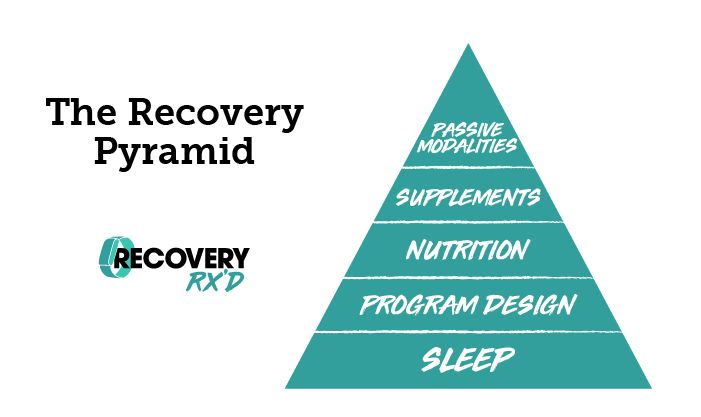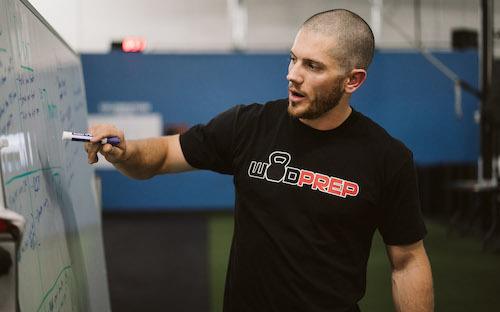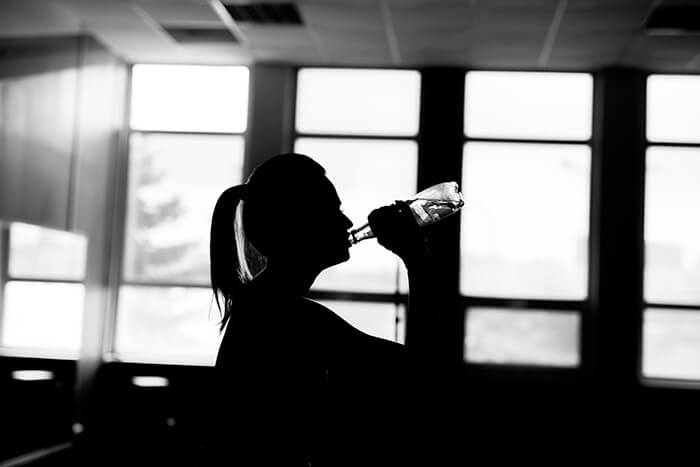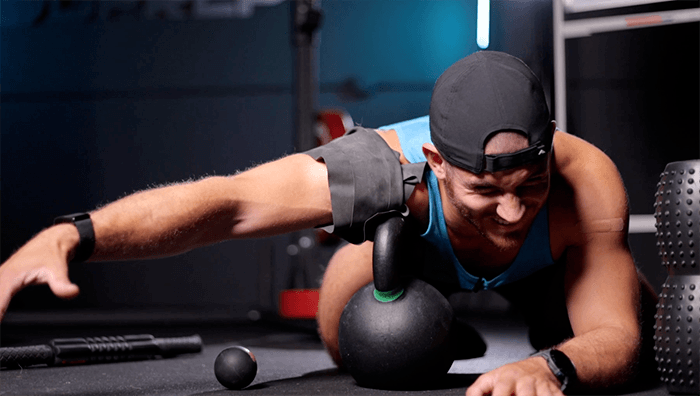Recovery is not just what you do in the 30 minutes after a workout. Conventional ‘recovery tips’ tend to focus on a very short post workout period and are focused on thinks like ‘do a cool down’, ‘do some stretching or mobility’, and ‘get protein right away.’ These are all fine, but do not really address the bigger recovery picture.
True recovery is a much longer process in which your body takes all the stress you just put it through and rebuilds itself stronger. Your energy systems, cardiovascular system, nervous system, muscles, bones, joints, and brain all need resources and time to properly recover.

Being aware of the larger goals and time frame for proper recovery is the first step toward optimizing this critical aspect of your fitness and getting the most out of your training.
As part of our new course Recovery Rx’d, we have outlined the 5 key elements of great recovery and built them stepwise into a pyramid. Start by establishing a solid foundation and then build your best recovery in this order.

Are you more of a visual learner? You can watch myself, Coach Ben and Dr CJ discussing all of these points in this video:
Recovery Strategy #1: Sleep

Sleep is your most important recovery tool. Sleep is the time when your body gets busy repairing, healing, and building. It’s when you are most anabolic (where the body builds and repairs muscle and other tissue as opposed to a catabolic state that involves the process of breaking down tissue).
The majority of your growth hormone production happens during deep sleep, so it’s vital to your fitness gains and recovery that you protect this time and make sure that you get adequate amounts of good quality deep sleep each night.
Learning and skill work also get consolidated and turned into movement patterns in your brain while you are sleeping.
Sleep is as foundational to your fitness as nutrition and exercise. It should be prioritized, tracked, planned for, and supported.
We are used to thinking about training programs and diet in this way, but often leave sleep out of the equation.
Better sleep translates to bigger gains from your training, better hormone regulation, improved mood, more energy and motivation, and faster recovery from your workouts.
Great sleep starts with routine. Focus on getting into and out of bed at similar times each day. Get bright sunlight to help set your internal clock every morning and avoid screens and bright lights in the hours leading up to bedtime.
Recovery Strategy #2: Program Design

Your programming should be set up with you in mind. If you’re following a generic program – like the one your box posts everyday – it’s up to you to track your intensity and output to make sure you are not over training.
If you go in everyday and throw down 100% effort to stay top-of-the-class, you’re charging towards the edge of a cliff with burn out and injury waiting for you when you fall off the edge.
We all love that all-out, sweat angel, nothing left in the tank, post-WOD feeling. But doing that every training session is counterproductive to improving your fitness and does not allow your body to properly recover.
Programming that factors in appropriate rest and recovery time, mixes in lower intensity workouts, and incorporates appropriate volume for strength and skills training is ideal. Your program should align with your fitness level, age, and fitness goals.
Your body simply cannot out recover bad programming.
Recovery Strategy #3: Nutrition

Once you’ve dialed in your sleep and programming, nutrition and hydration are the next critical pieces for supporting your body as it recovers.
When you workout, you cause tiny amounts of damage to your tissues (muscles, joints, bones, etc) and you burn through stored fuel. Repairing this damage is what ultimately makes you stronger, faster, leaner, and more fit. Your body needs to have materials available to flush out some of the damaged parts, rebuild damaged tissue, and replenish energy stores. You get those materials through good hydration and nutrition.
In your post workout period, your body primarily needs protein and some carbohydrates. The window of opportunity here is wider than most people think. Ideally, you want to get plenty of protein and a moderate amount of carbohydrates within 4 hours of training. You also need to drink lots of water before, during, and after intense activity.
Recovery Strategy #4: Supplements

Some people are reluctant to take supplements because they want to be ‘natural’, and get everything they need from a healthy diet. While we agree that a healthy diet is very important, there are certain nutrients that are hard to get in sufficient amounts through diet alone.
A great example of this is collagen. Collagen production declines starting in our 20’s, meaning less material to support joint and connective tissue maintenance and repair. Taking collagen can help make up for your bodies’ inability to make as much as it used to, allowing your joints and connective tissue to repair more quickly and stay healthy longer.
Other supplements that may be helpful additions for your workout recovery include creatine, magnesium, and protein powder.
Recovery Strategy #5: Passive Modalities

Passive modalities include foam rolling, massage, vibration, ice baths, electric muscle stimulation, etc. There are all sorts of tools and procedures being sold to athletes for ‘recovery.’
While there is nothing inherently wrong with these tools, they should be the last thing you focus on for your recovery. No amount of massage will make up for missing sleep and poor program design. In our experience, we find athletes rely too much on passive recovery and overlook the bigger more impactful elements.
If you have some tools that work well for you and you like using them, great.
If, however, you hate smashing your muscles with a lacrosse ball and are only doing it because you’re afraid that you won’t recover well without it, try giving it a rest for a week or two. Focus on the foundations of the recovery pyramid and see how you feel.
Most athletes will find they have great recovery and feel awesome with very little use of passive recovery tools.
Want all of this info in a pretty PDF to keep, refer back to or send on to a friend? Download it for free here!
If you’re ready to really dial in your recovery and maximize the benefits you get from your training, we can help! Our brand new course, Recovery Rx'd is designed for CrossFitters who want to take control of their recovery and stop feeling beat up day, in day out! Join the course here.
